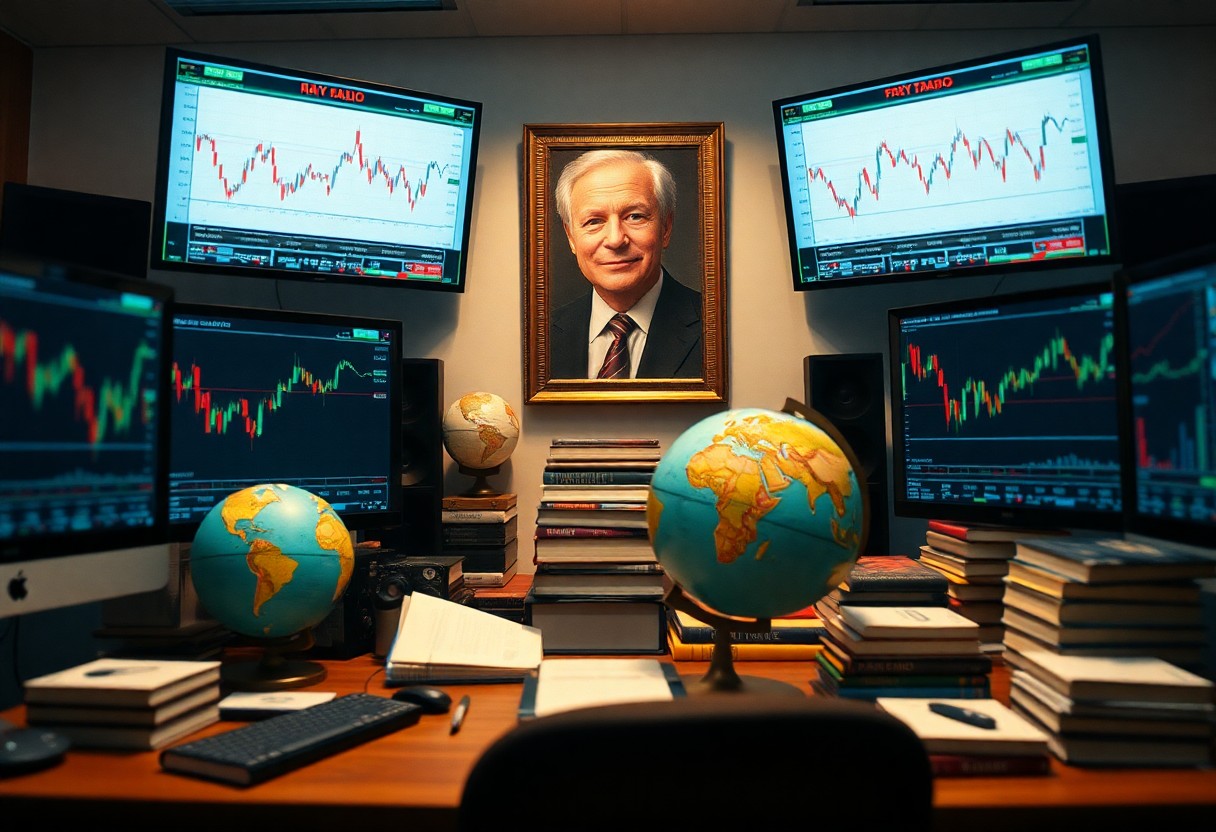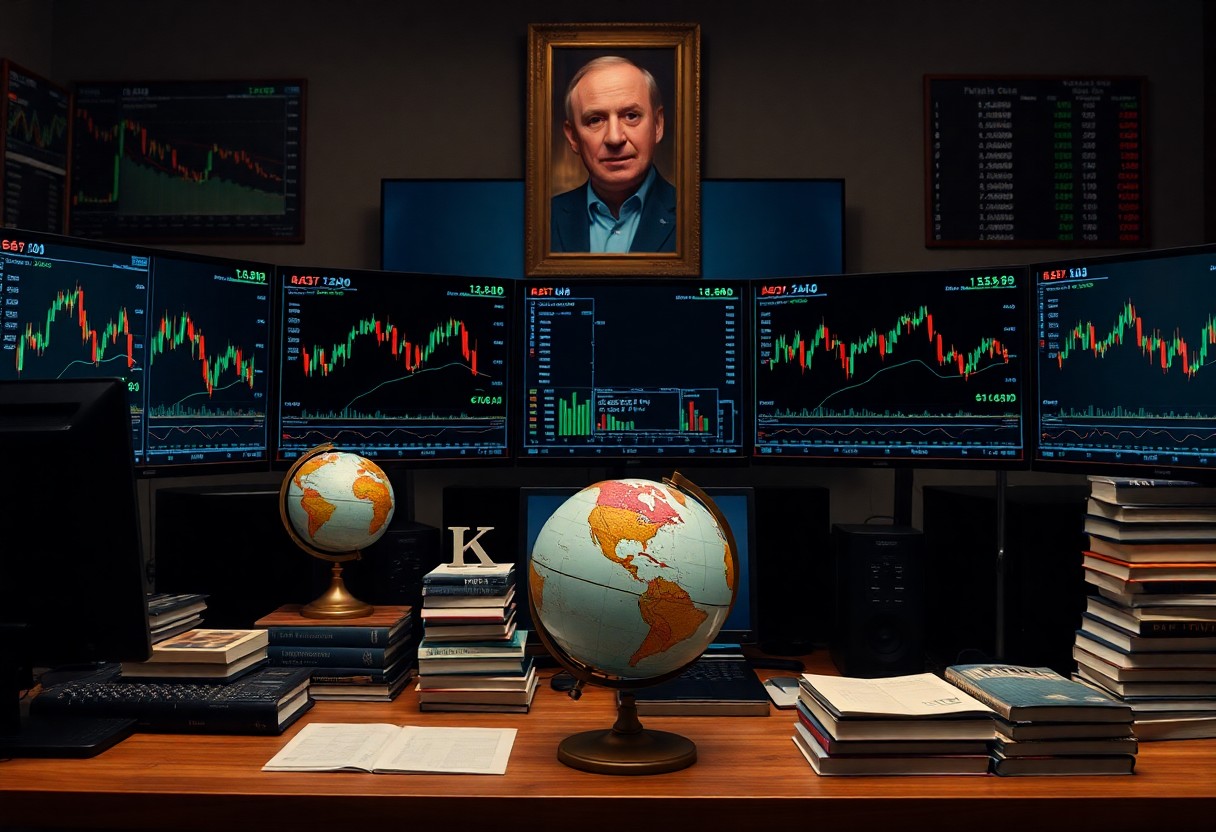Just as Ray Dalio harnesses economic principles to navigate the complex world of Forex trading, you too can learn to apply these strategies for better outcomes. By understanding macroeconomic indicators and recognizing market trends, you can improve your trading decisions and manage risks effectively. In this post, we’ll explore how you can incorporate Dalio’s methods into your own trading practices, ultimately enhancing your potential for success in the highly dynamic Forex market.

Key Takeaways:
- Principles of Economics: Understanding fundamental economic indicators is vital for analyzing forex market movements.
- Market Timing: Ray Dalio emphasizes the importance of timing in forex trading, suggesting that traders should make decisions based on economic cycles.
- Diversification: Dalio advocates for a diversified portfolio to manage risk across various currency pairs effectively.
- Macro Analysis: A strong focus on macroeconomic trends can provide insights into potential currency price fluctuations.
- Risk Management: Implementing robust risk management strategies is crucial to minimize losses and protect capital.
- Behavioral Economics: Understanding market psychology and trader behavior can enhance decision-making processes in forex trading.
- Data-Driven Decision Making: Leveraging data analytics and backtesting helps refine trading strategies and improve overall performance.

Understanding Economic Principles
Before exploring into Forex trading, it’s necessary for you to grasp the fundamental economic principles that govern global financial markets. These concepts help you interpret market behavior and make informed trading decisions. By understanding how various economic forces interact, you can develop a solid foundation for your trading strategy, ultimately leading to more successful outcomes.
Supply and Demand Fundamentals
The relationship between supply and demand plays a pivotal role in determining currency values in Forex markets. When demand for a currency exceeds its supply, the currency appreciates in value, and conversely, when supply outweighs demand, the currency depreciates. Recognizing these patterns will enable you to predict potential market movements effectively.
Market Cycles and Economic Indicators
To navigate the complexities of Forex trading, you must familiarize yourself with market cycles and key economic indicators that signal market shifts. Understanding these can enhance your ability to anticipate price movements, allowing you to align your trading strategies with prevailing economic trends.
Fundamentals such as interest rates, inflation, and employment figures are significant economic indicators that influence currency valuations. Market cycles often reflect periods of expansion and contraction, which you can analyze to identify favorable trading opportunities. For instance, when economic growth is strong, demand for a currency typically increases, while in times of recession, currency values may drop. By paying attention to these indicators and cycles, you’ll better position yourself to capitalize on positive trends and avoid potential pitfalls in your trading journey.

Ray Dalio’s Investment Philosophy
Some of Ray Dalio’s investment philosophy revolves around understanding economic principles and their impact on markets. His approach emphasizes systematic thinking, where you analyze historical data to predict future trends, enabling you to make informed decisions in Forex trading. Dalio’s successful strategies stem from a balanced combination of intuition and empirical evidence, allowing you to navigate the complexities of the financial world with greater confidence.
Principles of Radical Open-Mindedness
Against conventional wisdom, Ray Dalio promotes radical open-mindedness, encouraging you to challenge your own beliefs and embrace differing viewpoints. This principle allows you to identify biases in your thinking, ultimately leading to better trading decisions and enhanced adaptability in the ever-changing Forex market.
The Importance of Diversification
With the fast-paced nature of Forex trading, diversification acts as a safeguard against market volatility. It’s important for you to spread your investments across different currencies and asset classes to mitigate risk. In doing this, you protect your portfolio from sharp downturns that may affect a single asset, ensuring a more stable return on investment.
Plus, embracing diversification can significantly enhance your performance when trading Forex. By allocating your resources across various currencies, asset classes, and even geographical regions, you can reduce systematic risk and improve resilience against unforeseen market fluctuations. This strategy not only safeguards your investments but can also lead to better overall returns, giving you the stability needed to navigate the unpredictable nature of global markets confidently.
Analyzing Currency Pairs
To effectively engage in forex trading, you must analyze currency pairs thoroughly. This involves understanding how various factors like economic indicators, political events, and market sentiment impact the value of one currency against another. By staying informed and applying economic principles, you can identify trends and make educated decisions about your trades.
Major Currencies and Their Economic Backdrop
On a global scale, major currencies such as the USD, EUR, and JPY serve as benchmarks in the forex market. Each currency reflects its country’s economic condition, monetary policy, and geopolitical stability. For instance, the strength of the U.S. economy often drives demand for the USD, while European Union policies influence the EUR. Recognizing these connections can enhance your trading strategy.
Technical vs. Fundamental Analysis
Technical analysis focuses on price movement and historical data while fundamental analysis examines economic indicators and news events impacting currency value. Both methods offer valuable insights, but it’s important to choose the approach that aligns with your trading style and objectives.
Economic indicators such as GDP growth, unemployment rates, and inflation are vital for fundamental analysis, as they provide insight into a country’s economic health. Conversely, technical analysis relies on charts and patterns to predict future price movements based on past performance. The integration of both strategies can furnish you with a more comprehensive understanding of market dynamics, equipping you to navigate trading challenges while seizing lucrative opportunities. Be aware, however, that over-reliance on one method may lead to undesirable trading outcomes.
Risk Management Strategies
Keep in mind that effective risk management is the cornerstone of successful Forex trading. A solid strategy not only protects your capital but also enhances your potential to profit in the long run. By carefully assessing your risk tolerance and employing various techniques, you can navigate the turbulent waters of the Forex market with greater confidence.
Position Sizing and Leverage
Above all, understanding position sizing and leverage is vital to managing your risk effectively. The amount of capital you allocate to a trade should correlate with your total trading capital and risk tolerance. Keep your leverage at a manageable level to avoid overexposure and significant losses.
Emotional Discipline in Trading Decisions
To maintain emotional discipline during trading, you must recognize the impact your feelings can have on your decisions. Setting a clear trading plan and sticking to it can help you resist impulsive actions driven by fear or greed.
Hence, embracing emotional discipline is fundamental in Forex trading. A well-defined plan can keep you anchored, helping you avoid the pitfalls of high-stakes emotions that often cloud judgment. Establish your trading rules, including entry and exit points, and remind yourself to adhere to them, irrespective of market volatility. Your ability to stay composed and make rational decisions will ultimately lead to better outcomes and more sustained success in your Forex trading endeavors.
The Role of Macro Events in Forex Trading
Once again, understanding the role of macro events in Forex trading is imperative for making informed decisions. Economic indicators, political changes, and global crises can significantly impact currency values. By staying up-to-date on these macro events, you can better anticipate market movements and adjust your trading strategies. The interconnectedness of global economies means that events in one part of the world may ripple through the Forex market, affecting your trades.
Central Bank Policies and Interest Rates
Forex traders closely monitor central bank policies and interest rates, as these factors directly influence currency values. Changes in interest rates can lead to capital inflow or outflow, affecting demand for a currency. When you understand the monetary policies of central banks, you can predict how currency pairs may react to interest rate changes, thus enhancing your trading strategy.
Geopolitical Risks and Market Volatility
Policies that lead to geopolitical risks can significantly affect market volatility. As a trader, geopolitical tensions, conflicts, and diplomatic relationships can create uncertainty, driving currency pairs to fluctuate wildly. Being aware of these developments can enable you to navigate risks more effectively and seize opportunities that arise amid market turmoil.
A keen awareness of geopolitical risks can provide you with an edge in Forex trading. Events such as trade wars, election outcomes, or international sanctions can create sudden shifts in market sentiment. These developments can either strengthen or weaken currencies, leading to unexpected volatility. By monitoring such events and understanding their potential impacts, you can better position yourself to take advantage of opportunities while minimizing risks. Constant vigilance is required, as the landscape can change rapidly, impacting your trading strategies.
Practical Steps to Implement Dalio’s Strategies
After gaining insights into Ray Dalio’s economic principles, the next step is to act upon them through structured strategies. You’ll need to identify how you can blend these principles with your own trading philosophy to develop a robust approach. By utilizing Dalio’s methods of diversification and risk evaluation, you can enhance your chances of success in Forex trading.
Developing a Trading Plan
With a well-structured trading plan, you can outline your goals, risk tolerance, and trading style. Start by specifying your time frame and identifying the economic indicators that align with Dalio’s strategies. This plan serves as the backbone for your trading operations, allowing you to make informed decisions that align with your financial aspirations.
Continual Learning and Adaptation
Against a backdrop of rapidly changing market conditions, your ability to continually learn and adapt is imperative in Forex trading. Stay informed about global economic developments and examine how they influence currency movements. An adaptable mindset allows you to reassess your strategies and alter your approach based on real-time data.
But adopting a mindset of continuous improvement requires a commitment to education and self-reflection. Regularly analyze your trading performance and seek out resources to deepen your understanding of the markets. Engaging with a community of traders can help you gain new perspectives, while also enabling you to identify potential pitfalls in your approach. The key is to embrace uncertainty and continually refine your strategies to keep pace with the dynamic nature of the Forex market.
Conclusion
Presently, applying economic principles to Forex trading can significantly enhance your strategies, as demonstrated by Ray Dalio’s successful methodologies. By understanding macroeconomic indicators, you optimize your decision-making process and improve your potential to navigate the complexities of the currency market. Emphasizing risk management and diversification, you can align your trading with broader economic trends, ultimately leading to more informed and strategic trades. Leverage these insights to refine your approach and increase your chances of success in Forex trading.
FAQ
Q: What economic principles does Ray Dalio apply to Forex trading?
A: Ray Dalio emphasizes understanding macroeconomic factors such as interest rates, inflation, and geopolitical events that can influence currency values. He uses a holistic approach to analyze how these variables interact and affect currency movements, allowing traders to anticipate shifts in the Forex market.
Q: How does Ray Dalio’s concept of ‘radical transparency’ impact Forex trading decisions?
A: Dalio’s idea of ‘radical transparency’ promotes open dialogue and sharing of information among team members. In Forex trading, this principle encourages effective communication and collaboration among traders, leading to more informed decision-making processes and improved trading strategies based on collective insights.
Q: What role does diversification play in Dalio’s Forex trading strategies?
A: Diversification is a key component of Ray Dalio’s investment philosophy. He advocates for spreading investments across various currencies and asset classes to reduce risk and enhance returns. In Forex trading, this means not only trading multiple currency pairs but also considering different economic conditions that can impact those currencies.
Q: How does Dalio utilize data analysis in Forex trading?
A: Dalio employs a data-driven approach, utilizing historical data and statistical models to identify patterns and trends in currency movements. By analyzing past performance and economic indicators, traders can make more informed predictions about future currency behaviors, leading to better trading strategies.
Q: What specific indicators does Dalio recommend for analyzing currency movements?
A: Ray Dalio suggests examining indicators such as interest rate differentials, purchasing power parity, and economic growth rates. By evaluating these metrics, traders can gauge the relative strength of currencies and make more strategic trading decisions based on expected future performance.
Q: How does Dalio address risk management in Forex trading?
A: Risk management is integral to Dalio’s strategies. He advocates for setting clear risk thresholds and employing stop-loss orders to limit potential losses. Additionally, he stresses the importance of understanding one’s own risk tolerance and adjusting positions accordingly to protect capital while aiming for profitability.
Q: What is the significance of macroeconomic cycles in Dalio’s Forex trading approach?
A: In Dalio’s framework, recognizing macroeconomic cycles is important for successful Forex trading. He posits that different economic phases (expansion, peak, recession, and recovery) influence currency valuations. By assessing where the global economy stands in these cycles, traders can anticipate which currencies may appreciate or depreciate, informing their trading tactics accordingly.
Other Analysis Today


